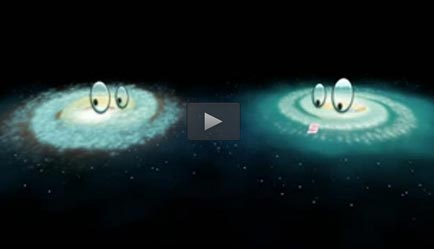What happens when cosmic giants meet galactic dwarfs?

A short, one minute entertaining and engaging animation showing what happens when big galaxies meet little galaxies. Credit: The International Centre for Radio Astronomy Research
The research, published today, also found that when two galaxies of the same size collide, both galaxies produce stars at a much faster rate.
Astrophysicist Luke Davies, from The University of Western Australia node of the International Centre for Radio Astronomy Research (ICRAR), says our nearest major galactic neighbour, Andromeda, is hurtling on a collision course with the Milky Way at about 400,000 kilometres per hour.
“Don't panic yet, the two won't smash into each other for another four billion years or so,” he says.
“But investigating such cosmic collisions lets us better understand how galaxies grow and evolve.”
Previously, astronomers thought that when two galaxies smash into each other their gas clouds–where stars are born–get churned up and seed the birth of new stars much faster than if they remained separate.
However Dr Davies' research, using the Galaxy and Mass Assembly (GAMA) survey observed using the Anglo-Australian Telescope in regional New South Wales, suggests this idea is too simplistic.
He says whether a galaxy forms stars more rapidly in a collision, or forms any new stars at all, depends on if it is the big guy or the little guy in this galactic car crash.
“When two galaxies of similar mass collide, they both increase their stellar birth rate,” Dr Davies says.
“However when one galaxy significantly outweighs the other, we have found that star formation rates are affected for both, just in different ways.
“The more massive galaxy begins rapidly forming new stars, whereas the smaller galaxy suddenly struggles to make any at all.
“This might be because the bigger galaxy strips away its smaller companion's gas, leaving it without star-forming fuel or because it stops the smaller galaxy obtaining the new gas required to form more stars.”
The study was released today in the journal Monthly Notices of the Royal Astronomical Society, published by Oxford University Press.
So what will happen in four billion years to the Milky Way and Andromeda?
Dr Davies says the pair are like “cosmic tanks”–both relatively large and with similar mass.
“As they get closer together they will begin to affect each other's star formation, and will continue to do so until they eventually merge to become a new galaxy, which some call 'Milkdromeda',” he says.
###
Further Information:
ICRAR is a joint venture between Curtin University and The University of Western Australia with support and funding from the State Government of Western Australia.
Journal publication details:
'Galaxy and Mass Assembly (GAMA): the effect of close interactions on star formation in galaxies' in the Monthly Notices of the Royal Astronomical Society. Published online on 13/7/2015 at: http://mnras.
Contacts:
Dr Luke Davies
ICRAR – UWA (Perth, GMT +8:00)
Ph: +61 8 6488 7750 M: +61 466 277 672 E: luke.davies@icrar.org
Pete Wheeler
Media Contact, ICRAR (Perth, GMT +8:00)
Ph: +61 8 6488 7758 M: +61 423 982 018 E: pete.wheeler@icrar.org
Multimedia:
Images and an animation are available at: http://www.
Media Contact
All latest news from the category: Physics and Astronomy
This area deals with the fundamental laws and building blocks of nature and how they interact, the properties and the behavior of matter, and research into space and time and their structures.
innovations-report provides in-depth reports and articles on subjects such as astrophysics, laser technologies, nuclear, quantum, particle and solid-state physics, nanotechnologies, planetary research and findings (Mars, Venus) and developments related to the Hubble Telescope.
Newest articles

A universal framework for spatial biology
SpatialData is a freely accessible tool to unify and integrate data from different omics technologies accounting for spatial information, which can provide holistic insights into health and disease. Biological processes…

How complex biological processes arise
A $20 million grant from the U.S. National Science Foundation (NSF) will support the establishment and operation of the National Synthesis Center for Emergence in the Molecular and Cellular Sciences (NCEMS) at…

Airborne single-photon lidar system achieves high-resolution 3D imaging
Compact, low-power system opens doors for photon-efficient drone and satellite-based environmental monitoring and mapping. Researchers have developed a compact and lightweight single-photon airborne lidar system that can acquire high-resolution 3D…





















